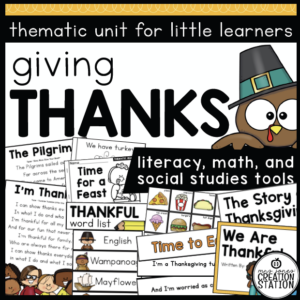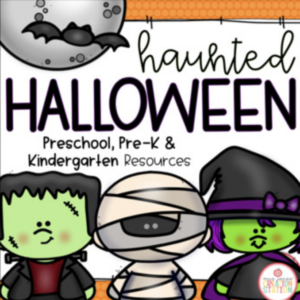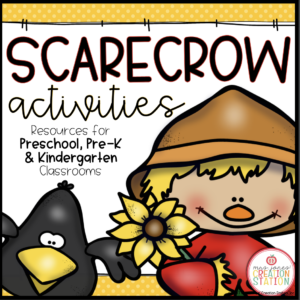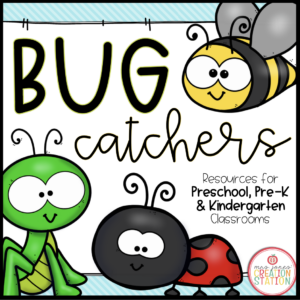FAIRY TALE ACTIVITIES FOR PRESCHOOL, PRE-K AND KINDERGARTEN
This fairy tales resource includes thematic lessons, activities, poems, songs, and centers for your little learners.
Buy the BUNDLE and SAVE! You can purchase this resources in the Thematic Activities for Little Learners Bundle and the Little Learners Mega-Bundle!
__________________________________________________________________
THIS RESOURCE INCLUDES
Lesson Resources
Fairy Tales – Whole Group
These resources can be used during whole group instruction for a fairy tale theme. They include a poem, word cards, tracing page and table sign in sheets.
Fairy Tale Interactive Poem
Use this poem during a thematic lesson, whole group or a literacy center and have learners tell different fairytale examples.
Lesson Plans
Fairy Tale Thematic Plans
Use these plans as a guide for engaging fairy tale read alouds and activities in the classroom. This unit focuses primarily on the characteristics of fairy tales by comparing two sets of fairy tales.
Fairy Tales
Have learners give examples of what a fairy tale is. Document on an anchor chart and add to it throughout the unit.
Set One
Read the first set of fairy tales throughout the school day. Set One includes The Three Billy Goats Gruff by Ronne Randall; Goldilocks and the Three Bears by Sarah Delmege; The Three Little Pigs by Kath Jewitt
Set One Anchor Chart
Create an anchor chart that includes the characters, setting, problem, and solution.
Set Two
Read the first set of fairy tales throughout the school day. Set One includes Jack and the Beanstalk by Ronne Randall; Little Red Riding Hood by Gaby Goldsack; Princess and the Pea by Dubravka Kolanovic
Set Two Anchor Chart
Create an anchor chart that includes the characters, setting, problem, and solution.
Let’s Compare
Compare and contrast characteristics of the fairy tales but listing similarities and differences. Print the titles to create the second anchor chart.
Fairy Tale Booklet
Have learners document the characteristics from the fairy tales and anchor charts in their fairy tale booklet.
Fairy Tale Sensory Charts
Explore fairy tales with the five senses. Complete the charts together and have learners draw and write about what it would be like to experience life in a fairy tale using their senses on the interactive page.
Fairy Tale Predictable Chart Class Book
Use this resource to create a class book from the predictable chart created during the week.
Literacy Centers
Literacy Center | Letter Formation
Have learners write and create each letter with manipulatives
Literacy Center | Letter Word Number Sort
Have learners sort the letters, words, and numbers on a pocket chart.
Literacy Center | Sight Words Read, Make, Write
Have learners read, make and write the sight words. The resources is editable.
Math Centers
Math Center | Addition
Have learners choose two cards to create and solve an addition problem.
Math Center | Making Ten
Have learners find the cards around the room and write the missing number needed to complete the ten frame.
Math Center | Number Puzzles
Have learners complete the puzzle by putting the numbers in order.
LEARNING STANDARDS INCLUDED IN THIS RESOURCE
Common Core Standards
Language Arts
CCSSL.K.1a
Print many upper- and lowercase letters.
CCSSL.K.5a
Sort common objects into categories (e.g., shapes, foods) to gain a sense of the concepts the categories represent.
CCSSRF.K.1b
Recognize that spoken words are represented in written language by specific sequences of letters.
CCSSRF.K.1c
Understand that words are separated by spaces in print.
CCSSRF.K.1d
Recognize and name all upper- and lowercase letters of the alphabet.
CCSSRI.K.7
With prompting and support, describe the relationship between illustrations and the text in which they appear (e.g., what person, place, thing, or idea in the text an illustration depicts).
CCSSRL.K.1
With prompting and support, ask and answer questions about key details in a text.
CCSSRL.K.2
With prompting and support, retell familiar stories, including key details.
CCSSRL.K.3
With prompting and support, identify characters, settings, and major events in a story.
CCSSRL.K.9
With prompting and support, compare and contrast the adventures and experiences of characters in familiar stories.
CCSSW.K.3
Use a combination of drawing, dictating, and writing to narrate a single event or several loosely linked events, tell about the events in the order in which they occurred, and provide a reaction to what happened.
Math
CCSSK.CC.B.5
Count to answer “how many?” questions about as many as 20 things arranged in a line, a rectangular array, or a circle, or as many as 10 things in a scattered configuration; given a number from 1-20, count out that many objects.
CCSSK.CC.A.2
Count forward beginning from a given number within the known sequence (instead of having to begin at 1).
CCSSK.NBT.A.1
Compose and decompose numbers from 11 to 19 into ten ones and some further ones, e.g., by using objects or drawings, and record each composition or decomposition by a drawing or equation (e.g., 18 = 10 + 8); understand that these numbers are composed of ten ones and one, two, three, four, five, six, seven, eight, or nine ones.
CCSSK.OA.A.1
Represent addition and subtraction with objects, fingers, mental images, drawings, sounds (e.g., claps), acting out situations, verbal explanations, expressions, or equations.
CCSSK.OA.A.4
For any number from 1 to 9, find the number that makes 10 when added to the given number, e.g., by using objects or drawings, and record the answer with a drawing or equation.
Texas Essential of Knowledge and Skills
Language Arts
TEKSLA.K.2.B.iv
Developing and sustaining foundational language skills: listening, speaking, reading, writing, and thinking–beginning reading and writing…. The student is expected to: demonstrate and apply phonetic knowledge by: identifying and reading at least 25 high-frequency words from a research-based list.
TEKSLA.K.2.C.iii
Developing and sustaining foundational language skills: listening, speaking, reading, writing, and thinking–beginning reading and writing… The student is expected to: demonstrate and apply spelling knowledge by: spelling high-frequency words from a research-based list.
TEKSLA.K.2.D.ii
Developing and sustaining foundational language skills: listening, speaking, reading, writing, and thinking–beginning reading and writing…The student is expected to: demonstrate print awareness by: holding a book right side up, turning pages correctly, and knowing that reading moves from top to bottom and left to right with return sweep.
TEKSLA.K.2.D.iv
Developing and sustaining foundational language skills: listening, speaking, reading, writing, and thinking–beginning reading and writing…The student is expected to: demonstrate print awareness by: recognizing the difference between a letter and a printed word.
TEKSLA.K.2.D.v
Developing and sustaining foundational language skills: listening, speaking, reading, writing, and thinking–beginning reading and writing…The student is expected to: demonstrate print awareness by: identifying all uppercase and lowercase letters.
TEKSLA.K.2.E
Developing and sustaining foundational language skills: listening, speaking, reading, writing, and thinking–beginning reading and writing…The student is expected to: develop handwriting by accurately forming all uppercase and lowercase letters using appropriate directionality.
TEKSLA.K.5.D
Comprehension skills: listening, speaking, reading, writing, and thinking using multiple texts. The student uses metacognitive skills to both develop and deepen comprehension of increasingly complex texts. The student is expected to: create mental images to deepen understanding with adult assistance.
TEKSLA.K.5.F
Comprehension skills: listening, speaking, reading, writing, and thinking using multiple texts. The student uses metacognitive skills to both develop and deepen comprehension of increasingly complex texts. The student is expected to: make inferences and use evidence to support understanding with adult assistance.
Response Skills
TEKSLA.K.6.B
Response skills: listening, speaking, reading, writing, and thinking using multiple texts. The student responds to an increasingly challenging variety of sources that are read, heard, or viewed. The student is expected to: provide an oral, pictorial, or written response to a text.
TEKSLA.K.6.C
Response skills: listening, speaking, reading, writing, and thinking using multiple texts. The student responds to an increasingly challenging variety of sources that are read, heard, or viewed. The student is expected to: use text evidence to support an appropriate response.
TEKSLA.K.6.D
Response skills: listening, speaking, reading, writing, and thinking using multiple texts. The student responds to an increasingly challenging variety of sources that are read, heard, or viewed. The student is expected to: retell texts in ways that maintain meaning.
Genres
TEKSLA.K.7.A
Multiple genres: listening, speaking, reading, writing, and thinking using multiple texts–literary elements. The student recognizes and analyzes literary elements within and across increasingly complex traditional, contemporary, classical, and diverse literary texts. The student is expected to: discuss topics and determine the basic theme using text evidence with adult assistance.
TEKSLA.K.7.B
Multiple genres: listening, speaking, reading, writing, and thinking using multiple texts–literary elements. The student recognizes and analyzes literary elements within and across increasingly complex traditional, contemporary, classical, and diverse literary texts. The student is expected to: identify and describe the main character(s).
TEKSLA.K.7.C
Multiple genres: listening, speaking, reading, writing, and thinking using multiple texts–literary elements…The student is expected to: describe the elements of plot development, including the main events, the problem, and the resolution for texts read aloud with adult assistance.
TEKSLA.K.7.D
Multiple genres: listening, speaking, reading, writing, and thinking using multiple texts–literary elements. The student recognizes and analyzes literary elements within and across increasingly complex traditional, contemporary, classical, and diverse literary texts. The student is expected to: describe the setting.
TEKSLA.K.8.A
Multiple genres: listening, speaking, reading, writing, and thinking using multiple texts–genres. The student recognizes and analyzes genre-specific characteristics, structures, and purposes within and across increasingly complex traditional, contemporary, classical, and diverse texts. The student is expected to: demonstrate knowledge of distinguishing characteristics of well-known children’s literature such as folktales, fables, fairy tales, and nursery rhymes.
Math
TEKSMA.K.2.A
Number and operations. The student applies mathematical process standards to understand how to represent and compare whole numbers, the relative position and magnitude of whole numbers, and relationships within the numeration system. The student is expected to: count forward and backward to at least 20 with and without objects.
TEKSMA.K.2.B
Number and operations. The student applies mathematical process standards to understand how to represent and compare whole numbers, the relative position and magnitude of whole numbers, and relationships within the numeration system. The student is expected to: read, write, and represent whole numbers from 0 to at least 20 with and without objects or pictures.
TEKSMA.K.2.I
Number and operations. The student applies mathematical process standards to understand how to represent and compare whole numbers, the relative position and magnitude of whole numbers, and relationships within the numeration system. The student is expected to: compose and decompose numbers up to 10 with objects and pictures.
TEKSMA.K.3.A
Number and operations. The student applies mathematical process standards to develop an understanding of addition and subtraction situations in order to solve problems. The student is expected to: model the action of joining to represent addition and the action of separating to represent subtraction.
TEKSMA.K.8.A
Data analysis. The student applies mathematical process standards to collect and organize data to make it useful for interpreting information. The student is expected to: collect, sort, and organize data into two or three categories.




